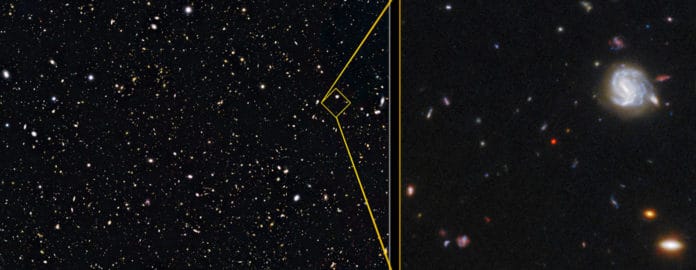Understanding how supermassive black holes form and grow in the early Universe has become a major challenge. Now, astronomers believe they’ve discovered a critical “missing link” out in space from the beginning of the Universe.
Using data from NASA’s Hubble Space Telescope, astronomers identified a rapidly growing black hole in the early Universe. This black hole, named GNz7q, is considered as missing link between young star-forming galaxies and the first supermassive black holes.
Existed just 750 million years after the big bang, the GNz7q is a newly formed black hole. Hubble detected a compact source of ultraviolet (UV) and infrared light consistent with the radiation expected from materials that are falling onto a black hole.
Only theories and computer simulations have predicted rapidly growing black holes in dusty, early star-forming galaxies. But, they have not been observed until now.
Seiji Fujimoto, an astronomer at the Niels Bohr Institute of the University of Copenhagen, said, “Our analysis suggests that GNz7q is the first example of a rapidly growing black hole in the dusty core of a starburst galaxy at an epoch close to the earliest supermassive black hole known in the universe.”
“The object’s properties across the electromagnetic spectrum are in excellent agreement with predictions from theoretical simulations.”
How did supermassive black holes, with millions to billions of times the mass of the Sun, get to be so huge so fast? This remains the greatest mystery in astronomy.
Current theories suggest that supermassive black holes begin their lives in the dust-shrouded cores of vigorously star-forming starburst galaxies before expelling the surrounding gas and dust and emerging as extremely luminous quasars. Despite being rare, both star-forming “starburst” galaxies and extremely luminous quasars have been detected in the early Universe.
According to scientists, GNz7q could be a missing link between these two classes of objects. GNz7q has exactly both aspects of the dusty starburst galaxy and the quasar, where the quasar light shows the dust reddened color. Also, GNz7q lacks various features usually observed in typical, very luminous quasars (corresponding to the emission from the accretion disk of the supermassive black hole), which is most likely explained that the central black hole in GN7q is still in a young and less massive phase.
These properties perfectly match the young, transition phase quasar predicted in simulations but never identified in similarly high-redshift Universe as the very luminous quasars so far identified up to a redshift of 7.6.
Fujimoto said, “GNz7q provides a direct connection between these two rare populations and provides a new avenue toward understanding the rapid growth of supermassive black holes in the Universe’s early days. Our discovery provides an example of precursors to the supermassive black holes we observe at later epochs.”
While alternate interpretations of the team’s data cannot be ruled out completely, the observed features of GNz7q are very similar to theoretical predictions. The host galaxy of GNz7q produces stars at a rate of 1,600 solar masses per year, and GNz7q itself is bright in UV but dim in X-ray wavelengths.
A massive black hole’s accretion disc should be exceedingly luminous in UV and X-ray light. However, while Hubble identified UV light this time, even one of the most profound X-ray datasets failed to identify X-ray light. These findings indicate that the accretion disk’s center, where X-rays originate, is still veiled, while the outer section, where UV light creates, is becoming unobscured. According to this theory, GNz7q is a fast-expanding black hole hidden by the dusty core of its star-forming host galaxy.
Gabriel Brammer, another astronomer from the Niels Bohr Institute of the University of Copenhagen and a member of the team behind this result, said, “GNz7q is a unique discovery that was found just at the center of a famous, well-studied sky field — it shows that big discoveries can often be hidden just in front of you. It’s unlikely that discovering GNz7q within the relatively small GOODS-North survey area was just ‘dumb luck,’ but rather that the prevalence of such sources may be significantly higher than previously thought.”
Finding GNz7q hiding in plain sight was only possible thanks to the uniquely detailed, multiwavelength datasets available for GOODS-North. Without this richness of data, GNz7q would have been easy to overlook, as it lacks the distinguishing features usually used to identify quasars in the early Universe. The team now hopes to search for similar objects using dedicated high-resolution surveys systematically and to take advantage of the NASA James Webb Space Telescope’s spectroscopic instruments to study objects such as GNz7q in unprecedented detail.
Journal Reference:
- Fujimoto, S., Brammer, G.B., Watson, D. et al. A dusty compact object bridging galaxies and quasars at cosmic dawn. Nature 604, 261–265 (2022). DOI: 10.1038/s41586-022-04454-1
